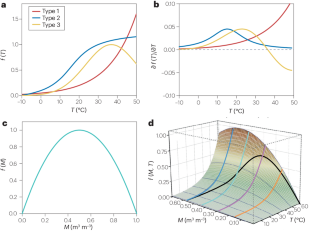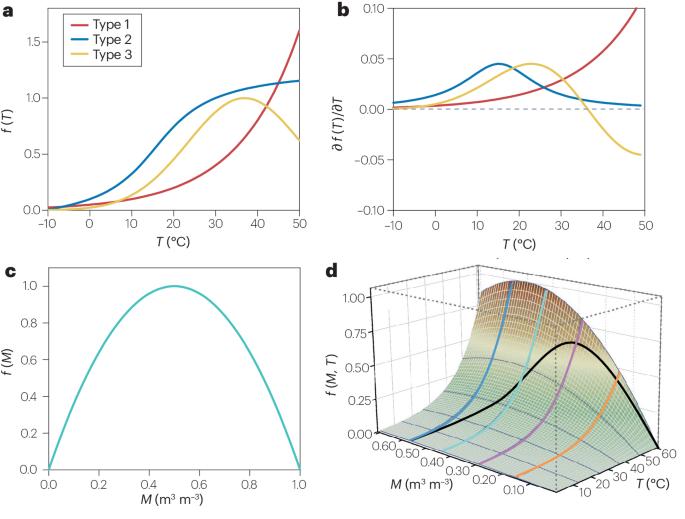Temperature responses of ecosystem respiration
引用次数: 0
Abstract
Terrestrial ecosystems release ~106–130 PgC yr–1 into the atmosphere through respiration, counterbalancing photosynthetic carbon uptake and determining the strength of the land carbon sink. The effect of anthropogenic warming on the land carbon sink will depend on the temperature response of respiration. In this Review, we explore the relationships between temperature and ecosystem respiration from experimental and observational data at leaf, microbial, ecosystem and global scales. Contrary to the assumed monotonic increase in respiration with increasing temperature derived from Earth system models, empirical findings indicate a unimodal temperature response with a peak in respiration at an optimal temperature (Topt). This unimodality is observed across a range of organization levels with Topt values of 40–60 °C at the leaf and plant level, 11–46 °C at a microbial level and 6.5–33.3 °C at the global scale. Various mechanisms contribute to this unimodal pattern including enzyme deactivation, the thermodynamics of enzyme-catalysed reactions and changes in temperature-dependent factors such as soil moisture, nutrient availability and vegetation physiology. Incorporating the unimodality of these observed temperature responses of ecosystem respiration into Earth system models could facilitate attribution studies to identify the mechanisms responsible for the peaked response and increase the accuracy of carbon sequestration predictions. The future of the land carbon sink depends on the temperature response of ecosystem respiration. This Review explores observational and experimental evidence for a unimodal temperature response of respiration and the implications for carbon sequestration predictions.


生态系统呼吸的温度响应
陆地生态系统每年通过呼吸作用向大气释放约 106-130 PgC,抵消光合作用的碳吸收,并决定陆地碳汇的强度。人为变暖对陆地碳汇的影响将取决于呼吸作用的温度响应。在本综述中,我们将从叶片、微生物、生态系统和全球尺度的实验和观测数据中探讨温度与生态系统呼吸作用之间的关系。与地球系统模型假定的呼吸作用随温度升高而单调增加的情况相反,实证研究结果表明,温度反应具有单模态性,呼吸作用在最佳温度(Topt)达到峰值。在一系列组织水平上都可以观察到这种单模性,叶片和植物水平的 Topt 值为 40-60℃,微生物水平的 Topt 值为 11-46℃,全球范围的 Topt 值为 6.5-33.3℃。造成这种单模态模式的机制多种多样,包括酶失活、酶催化反应的热力学以及土壤湿度、养分供应和植被生理等温度相关因素的变化。将观测到的生态系统呼吸的温度响应的单模性纳入地球系统模型,可促进归因研究,以确定峰值响应的机制,并提高固碳预测的准确性。陆地碳汇的未来取决于生态系统呼吸的温度响应。本综述探讨了呼吸作用单峰温度响应的观测和实验证据及其对固碳预测的影响。
本文章由计算机程序翻译,如有差异,请以英文原文为准。
求助全文
约1分钟内获得全文
求助全文

 求助内容:
求助内容: 应助结果提醒方式:
应助结果提醒方式:


